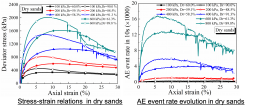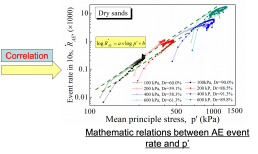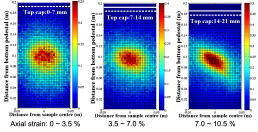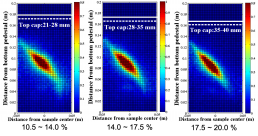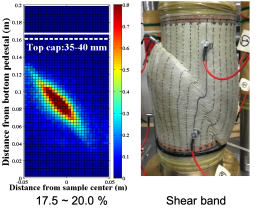Introduction / 序論
Studying the mechanical behavior of granular soils from micro-scale prospective is of fundamental importance. While Acoustic Emission (AE) technique has become a promising approach for this purpose, its synthetic and corroborative study on granular soils is far from substantive. To this end, AE technique was applied in this study to explore the micro-mechanical behavior of sands subjected to drained-triaxial compression.
粒状体である砂の力学的挙動を微視的(マイクロスケール)な観点から研究することは砂の挙動の根本的理解に欠かせないものである。物質の破壊の際に放出される音波を用いるアコースティック・エミッション(AE)法はこの目的に対するアプローチの一つとなりつつあるが、粒状体に対する利用の研究は未だ豊富であると言いがたい。本研究ではAE法を用いて排水三軸圧縮せん断を受ける砂の微視的挙動を把握することを目指す。
AE behaviors in sands with various ground conditions/ 様々な条件下での砂のAE特性
Several series of drained triaxial compression tests incorporated with AE measurement were conducted on sands with various conditions to corroborate and quantitatively interpret the relationship between AE behaviors and the macro-scale soil mechanical behaviors.
AE特性と砂の巨視的挙動の関係を定量的に分析するため、AEの計測を行いながら様々な条件下で砂の排水三軸圧縮せん断を行った。
Particle interactions in sands characterized by AE frequency response/ AE周波数による砂粒子の相互作用の特定
In order to reveal the quantification evolution of micro-scale behaviors in sands, particle interaction (i.e. particle-to-particle sliding & particle breakage) tests were conducted and the frequency response of their induced AE sources were analyzed. The result revealed the dependence of AE frequency on the mode of particle interactions, which could be further extended to quantify the evolution of particle-to-particle sliding and particle breakage behavior in sands subjected to drained triaxial compression.
砂地盤の内部の微視的な挙動の定量的な把握のため、粒子の滑動と破壊を手動で行い、それらのAEの周波数特性を分析した。その結果、滑動と破壊それぞれが特徴付けるAE周波数特性を得、その特性を利用して排水三軸圧縮を受ける砂内の粒子の滑動や破壊の進展を定量化することが可能と考えられる。
Development of AE 3D tracing technique and its application in sands / AEの三次元計測技術と砂への適用
An AE 3D tracing technique that could trace the origin time and 3D coordinates of particle interaction-induced AE sources was developed by MATLAB programming based on the idea of Time Difference of Arrival (TDOA). The results revealed its feasibility and successful applications in tracing the initiation and evolution of shear banding in saturated sands subjected to drained triaxial compression.
AEの発生時間と砂粒子の相互作用が起きた場所を特定することができるAEの三次元計測技術をTime Difference of Arrival (TDOA)をもとにMATLABのプログラムで開発した。この方法により、AE法による砂のせん断面の発生や発展の追跡が可能であることが示された。

